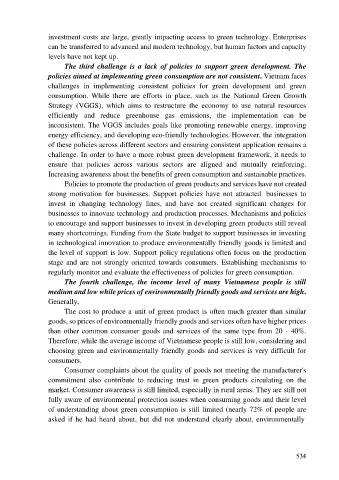Page 542 - Ebook HTKH 2024
P. 542
investment costs are large, greatly impacting access to green technology. Enterprises
can be transferred to advanced and modern technology, but human factors and capacity
levels have not kept up.
The third challenge is a lack of policies to support green development. The
policies aimed at implementing green consumption are not consistent. Vietnam faces
challenges in implementing consistent policies for green development and green
consumption. While there are efforts in place, such as the National Green Growth
Strategy (VGGS), which aims to restructure the economy to use natural resources
efficiently and reduce greenhouse gas emissions, the implementation can be
inconsistent. The VGGS includes goals like promoting renewable energy, improving
energy efficiency, and developing eco-friendly technologies. However, the integration
of these policies across different sectors and ensuring consistent application remains a
challenge. In order to have a more robust green development framework, it needs to
ensure that policies across various sectors are aligned and mutually reinforcing.
Increasing awareness about the benefits of green consumption and sustainable practices.
Policies to promote the production of green products and services have not created
strong motivation for businesses. Support policies have not attracted businesses to
invest in changing technology lines, and have not created significant changes for
businesses to innovate technology and production processes. Mechanisms and policies
to encourage and support businesses to invest in developing green products still reveal
many shortcomings. Funding from the State budget to support businesses in investing
in technological innovation to produce environmentally friendly goods is limited and
the level of support is low. Support policy regulations often focus on the production
stage and are not strongly oriented towards consumers. Establishing mechanisms to
regularly monitor and evaluate the effectiveness of policies for green consumption.
The fourth challenge, the income level of many Vietnamese people is still
medium and low while prices of environmentally friendly goods and services are high.
Generally,
The cost to produce a unit of green product is often much greater than similar
goods, so prices of environmentally friendly goods and services often have higher prices
than other common consumer goods and services of the same type from 20 - 40%.
Therefore, while the average income of Vietnamese people is still low, considering and
choosing green and environmentally friendly goods and services is very difficult for
consumers.
Consumer complaints about the quality of goods not meeting the manufacturer's
commitment also contribute to reducing trust in green products circulating on the
market. Consumer awareness is still limited, especially in rural areas. They are still not
fully aware of environmental protection issues when consuming goods and their level
of understanding about green consumption is still limited (nearly 72% of people are
asked if he had heard about, but did not understand clearly about, environmentally
534

